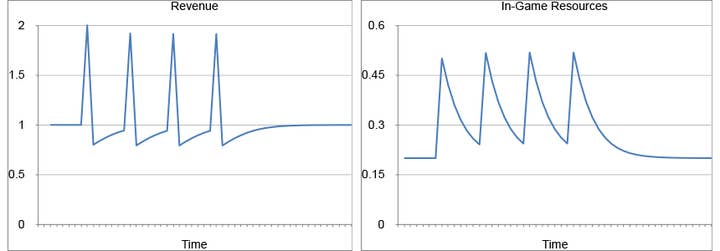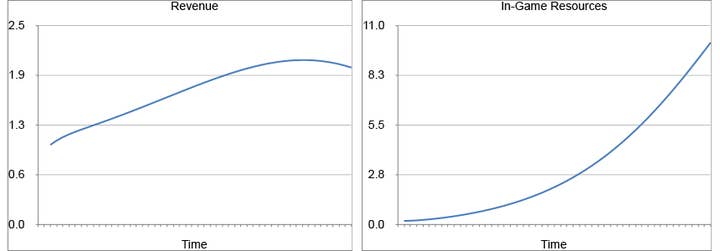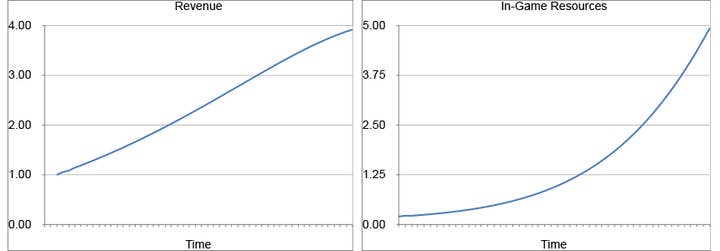F2P Economics: Inflation and the Perpetual Revenue Machine
Will Luton looks at how to increase IAP without upsetting players
Have you ever wonder how some F2P titles, such as Clash of Clans, never run IAP sales where others, such as Game of War, run them 24/7? In this article I will explain the economy of sales, the problems sales create and how intentionally inflating economies can solve existing problems (while creating some brand new ones).
An in game resource, normally one that has a direct exchange to real world time, is intentionally controlled to create a demand. The aim is create a balance such that players feel "pinched". In economics a "pinch point" defines the supply level at which a commodity becomes so scarce that consumers worry about security and so demand increases.
Good F2P economies are balanced to maximise the supply of a constrained resource such that players receive enough in order to understand the resource's utility but not enough to sate the player's desire for it. This knife edge balance creates an equilibrium in the game's economy where there is a float amount of the resource in the system, as the taps (sources of the resource) and sinks (where resources are destroyed) are in an equilibrium.
Economic Equilibrium
Within Clash of Clans both gold and elixir, the game's soft currencies, are always in demand through the balancing mechanics of escalating production and costs. Meanwhile the hard currency of jewels trickles in steadily every day, cannot be transferred and is regularly drained through speedups.
Effectively no resource within the game ever becomes so flooded or starved it breaks pinch. In addition Supercell never varies the IAPs through sales or the like. This makes Clash of Clans a game of theoretical perfect economic equilibrium with a flat IAP demand.
Supercell's approach however is an unusual one within the industry. More commonly developers offer IAP sales where the value of an IAP is spiked either by dropping prices or increasing the contents offered. However this approach brings with it a unique problem.
Sales and Shadows
The improved value proposition of an IAP sale spikes demand, as players' expectation of value, set outside of the sale, is beaten. In conjunction the time limit pushes the player to act quickly, generating large IAP volume and so revenue.
But this comes at a price to developers: Directly after a sale a game's economy becomes flooded with resources from the IAPs. This flooding does increase the rate of sinking as players become freed from the usual pinch, but in addition it also cripples demand. The resulting downturn is a shadow that can last days or weeks.
Therefor, a sale can only be considered profitable if the net revenue from the start of the sale until resource equilibrium, and so demand, is restored is more than if the sale hadn't been run. For well run sales in games with well balanced economies this should always be true.
I created some spreadsheet models where IAP revenue is directly correlated to a demand value that is in turn calculated from both IAP value and how far resources in the system are off from a pinch point. This does a reasonable job of reflecting real world revenue patterns in F2P games.

The above graph shows a one day sale every seven days. What we see is that as IAP value increases there is a drastic rise in demand and so revenue. But as I revenue increases so too does the total in game resources. The more resources in the system the greater the rate of sink as users become more frivolous. Yet this doesn't happen quick enough to stop demand from being negatively impacted.
Once the sale is turned off demand becomes low and revenue drops under the non-sale baseline. This is the shadow of the sale.
If a sale is started while the game's economy is still flooded then the promotion will be facing already lowered demand. This means that sales require the correct cadence otherwise they end up pushing demand perpetually lower.
What if there was a way that, instead of periodic sales that spike IAP value, we could vary IAP value such that we created continued IAP demand? Notionally this growth can be achieved through intentional and controlled inflation.
Inflation and the Continuous Sale
Earlier I described IAP demand as a function of IAP value and in-game resources, where the higher the IAP value and closer to the equilibrium (or pinch) point an economy is the greater the number of sales.
So what happens if we just run back-to-backs sales where the IAP value proposition continues to grow?

The good news is that initially the revenue grows, that is until the balancing factors of the game economy kicks in. In my model the economy becomes so flooded out that players no longer feel pinch and it becomes hard to offer value to keep pace. Ultimately pinch is completely destroyed which kills demand and revenue follows.
But perhaps there's a way to fix this issue. Let's run another hypothetical: What if we could make the sinks somehow scale with increased resources in the system?

Here we have created an intentionally inflated economy, where more and more resource is introduced into the system and everything becomes increasingly more expensive to balance that. We see the pinch is ever increasing and that revenue continues to climb.
Of course this model is theoretical and to create real revenue impact from IAP value inflation designers cannot simply increase costs across the game arbitrarily. This would create a series of demotivating moving goal post for all players and negate the feeling of increasing IAP value. Instead a more fair approach is to have a pipeline of late game content at an increasing cost.
These large late game costs can scale proportionately to IAP value inflation to create the sink needed to drain out the ever increasing resources in the system. Putting these larger sinks at the late game has an additional benefit: It reduces Latecomer Disadvantage.
Solving Latecomer Disadvantage
Latecomer Disadvantage occurs in games in which time is a strong factor in power or progression. New players introduced to the competitive environment are disadvantaged by the amount of time others have already invested in-game, creating a feeling that they are a fixed amount behind and will never catch up. This can lead to stagnant leaderboards and early to mid game churn.
Yet if the early game sinks remain static and taps are increased (both from IAP and in-game) then new players eat through early content much quicker than their elders did, closing the progression gap between them.

The above graphs show linear player progress over time for both a regular and inflated economy. Where inflation exists the progression discrepancy between each player is vastly reduced, increasing the chances of competition and so revenue and retention.
While this proposal of inflation can be dismissed as theoretical, similar mechanics have already been implemented and show to work.
Case Study: Game of War
In MZ's Game of War IAP packs offering hard currency (gold), resources (food, wood, stone etc), speedups and gatcha (chests) are trending toward increasing in value as these resources become more abundant in game.
As a pretty casual Game of War player (at least compared to many leaderboard players) over six months I felt the draw of ever more generous packs. Where you would consider a pack one day, and so set a personal anchor of value, later it would be exceeded. This made buying packs on some days seem very enticing and over my time in the game I happily spent several hundred dollars. I felt good about these purchases, feeling I had caught a bargain.
All of these advantages make inflation seem like a magical perpetual revenue machine. Yet in practice inflation, where it can even be applied at all, has been seen to have some rather large and worrying drawbacks.
The Problems of Inflation
Firstly, not all games are suitable to inflation. A prerequisite is a set of mechanics that can offer enough content to be able to produce increasing sinks for the title's lifetime. This is especially important when considering the accelerating rate at which new players will be eating though the game. For some genres of games this content pipeline or accelerated early game might prove impossible.
Secondly, building a well balanced, fun and fair static economy is hard enough. Introducing a rate of change over time makes designing content and features even harder. Designers need to consider not just how everything interacts now but in to the future. In addition analysts must continuously and closely watch how the economy is actually moving. Sinks and taps need to be increased or throttled constantly as supply and demand shifts in real time, increasing production demands and making mistakes more likely.
Finally, and most important of all, is how inflation impacts players. Around a year ago fansite Inside Game of War wrote a very thorough and considered post about how what they termed "hyperinflation" was negatively impacting the game. The piece was later pulled following what a Redditor claims was a cease and desist from MZ. However, discussion and an archive of the article can be found here.
In the case of Game of War, and any game with inflation, players will realise what is happening to the economy. Likely players will feel that their previous investments of both time and money are now devalued as new players race towards them more quickly and cheaply.
"Inflating an economy comes with some hard prerequisites and some serious pitfalls, yet it allows for unique and effective way to offer players a sense of continuous value"
In addition players see that the content that they are now consuming is becoming vastly more expensive in order to sink the inflated resources. This in turn reduces the feeling that IAP value is in fact improving and inflation simply becomes an understood and expected part of play.
Should You Inflate?
Inflating an economy comes with some hard prerequisites and some serious pitfalls, yet it allows for unique and effective way to offer players a sense of continuous value. More than just offering better IAPs inflation can give the appearance of generosity as in game taps increase.
While Game of War and Clash of Clans' approaches to IAP are very different, they both appear to be effective. Both titles and their kin (Clash Royale and Mobile Strike) sit alongside of them at the top of the Top Grossing charts applying similar methodologies.
However, more interesting is the consideration that both different approached of these titles are the outliers. The common practice of intermittent but frequent sales is the de facto amongst the industry, where peaks cause troughs and players become trained to wait to catch a discount.
As the F2P model evolves practices around sales and economy balance are likely to become more sophisticated. If inflation can be correctly controlled and transparently implemented, such that players don't feel burnt by it, there is a good chance it will become a powerful tool.








